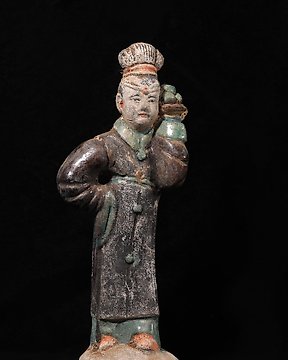
Forntida Kina Terrakotta Statyett för kvinnlig skötare (Utan reservationspris)
Nr 83864115

Nr 83864115

Han dynasty (206 BCE–220 CE)
Height: 20 cm. Width: 30 cm.
Good condition, much of the original pigment remaining.
Excavated from the tomb in Shaanxi province
Property from Very Important Private Collection
Note: The collection consists of ca. 30 pottery objects (including horses form the Six dynasties to Tang dynasty, attendants, musicians, guards of honour, camels), all pottery objects will be auctioned in the coming Catawiki auctions.
Provenance: Important Dutch private collection. Mrs. H. A. de Bruijn Kops.
Qualifications: draftsman, painter, watercolourist
Education: Institute Training for Drawing Teachers (Amsterdam)
Member of association: Professional Association of Visual Artists BBK
The family name is very known and one of the most important family in The Netherlands.
Here some information about the family: The grand- grandfather of Mrs. de Bruijn Kops, Cornelius Joannes de Bruyn Kops was mayor of Haarlem (1836-1858). De Bruyn Kops was, just like his father and grandfather, a manufacturer of linen and yarn in Haarlem. He also had a political career, he was a member of the city council (1816-1858), alderman (1833-1836) and mayor (1836-1858) in his birthplace. He was also a member of the Provincial Council of North Holland (1840-1850). In 1840 and 1848 he was elected extraordinary member of the House of Representatives from the Provincial Council. These additional members for the House were elected for the duration of the process for the purposes of the constitutional revisions in those years.
There is a book about the family and the family members “Stemmen uit een stille stad, (Intieme berichten uit Haarlem’s late regententijd)”
Note: It will be professionally packed and safely sent in a wooden crate within 3 working days by FedEx. Shipped with Insurance!
Our Guarantee: The above item is guaranteed to be of the time period and condition as described, has been purchased legally and is legal to buy and sell under all international laws to cultural patrimony.
- All items legal to buy/sell under The Netherlands covering cultural patrimony and are guaranteed to be as described or your money back.
- A Certificate of Authenticity from Becker Antiques (specialist in Chinese pottery since 1969, Amsterdam) will accompany the item.
Outstanding pottery "mingqi" representing a Pottery Rabbit.
Grey earthenware coated with white slip and remains black and white, red pigment
This exceptionally rare figure of a crouching rabbit modelled with the head lowered to the ground and long ears pricked upwards, white pigment remaining to the body and the facial details highlighted in red and black.
-Condition: Wear, old, aged patina, oxidation. Very good, preserved condition. Please be advised the piece is ca. 2000 years old.
Additional Information
The Han dynasty (206 BCE–220 CE)
The Han period saw the gradual abandonment of human immolation. Burial practices were adopted that required a large number of goods accompanying the dead. The result was an increase in demand of mortuary objects made of clay. To make sure that the deceased were well provisioned in the after world, tombs were furnished with rich variety of pottery objects including utilitarian vessels, male and female attendants, livestock, horses and carts, goose, and birds. These objects are fine example of Han pottery sculpture and provide useful information about everyday life of the Han people.
The first pottery to survive in appreciable quantities belongs to the Han dynasty; most of it has been excavated from graves. Perhaps the commonest form is the hu, a baluster-shaped vase copied from bronze vessels of the same name and sometimes decorated with relief ornament in friezes taken directly from a bronze original. The hill jar, which has a cover molded to represent the Daoist “Isles of the Blest,” is another fairly frequent form, and many models of servants, domestic animals, buildings, wellheads, dovecotes, and the like also have been discovered in graves.
Han glazed wares are chiefly of two types. Northern China saw the invention, presumably for funerary purposes only, of a low-fired lead glaze, tinted bottle-green with copper oxide, that degenerates through burial to an attractive silvery iridescence. High-fired stoneware with a thin brownish to olive glaze was still being made in Henan, but the main centre of production was already shifting to the Zhejiang region, formerly known as Yue. Yue ware kilns of the Eastern Han, located at Deqing in northern Zhejiang, produced a hard stoneware, often imitating the shapes of bronze vessels and decorated with impressed, bronze like designs under a thin olive glaze. Other important provincial centres for pottery production in the Han dynasty were Changsha (in Hunan province) and Chengdu and Chongqing (in Sichuan province).[1]
Important information.
The seller guarantees that he is entitled to ship this lot.
It will be professionally packed and safely sent by FedEx.
Buyers are responsible for import regulation and restrictions of their own country.
Hur du köper på Catawiki
1. Upptäck något speciellt
2. Lägg det högsta budet
3. Gör en säker betalning